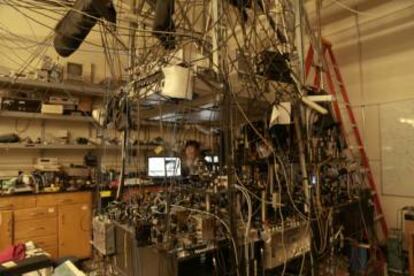When dark photons are probed by falling atoms
If dark matter has its own dark version of light, very precise measurements of atoms could reveal its behavior

By bouncing light off falling atoms, physicists at the University of California, Berkeley precisely measured the force that governs electric charge, magnets, and light. This measurement has far-reaching implications for physics, from uncovering what¡¯s inside an electron, to understanding the behavior of dark matter in distant galaxies.
As described in their April 13th paper in Science, physicists carefully studied the way Cesium atoms react to being hit by particles of light, photons. They launched the Cesium atoms up a few meters to the top oftheirapparatus, and then bombarded them with photons as they fell back down.
Their result tests the boundary of known physics and may hint to what lies beyond
Using Cesium atoms, these physicists measured the fine-structure constant more precisely than any experiment has so far achieved. The fine-structure constant sets the strength of the electromagnetic force, responsible for a plethora of physical phenomenon and famous for its role in electricity, magnetism, and light.
Their reported value of the fine-structure constant is so precise that uncertainty does not show itself until the tenth decimal place. This is comparable to measuring the length of the Grand Canyon to within the width of a human hair. Their result tests the boundary of known physics and may hint to what lies beyond.
For example, this measurement can test for dark matter, a mysterious substance believed to surround galaxies, and responsible for 27% of the mass and energy in the universe. Some physicists theorize that dark matter could interact with a dark photon, dark matter's own versionof?light.If dark photons do exist, experiments might show an unexpected value of the fine-structure constant.

Holger M¨¹ller, principal investigator and co-author of this work, says the dark photons his experiment probes would interact with dark matter particles. According to M¨¹ller, this dark photon is ¡°a messenger particle that can talk to both dark matter and regular matter.¡± If dark photons are real, they may provide the first signal of dark matter¡¯s existence.
This measurement also leads to information about the interior of a familiar particle, the electron. If the electron is made up of other, hidden particles, they too would affect the fine-structure constant. M¨¹ller¡¯s group did not see this effect. We now know either the particles inside the electron have weaker effects than previously allowed, or the electron is not composed of any new particles.
The technology that enables this precision measurement is called matter-wave interferometry. Physicists have long known that matter, such as atoms, can behave like a wave. M¨¹ller¡¯s group can manipulate these matter waves and make them interfere with each other, similar to ripples in a pond. As the Cesium atoms fall within their experiment, their matter waves interfere. The interference reveals and enhances subtle properties of the atoms. Here, it was used to test the recoil of Cesium after being hit with photons.
We worked so we understood all surprises, until they were not surprises anymore
Holgen M¨¹ller, researcher
For even higher precision, M¨¹ller¡¯s group endeavored to understand and reduce every possible source of error in their experiment. To prevent bias, they performed their experiment blind, meaning they hid from themselves the true value of what they were measuring. M¨¹ller said that he was naturally a bit nervous when his group unblinded the result for the first time. To ensure the result would be legitimate when revealed, his group double-checked all aspects of their experiment and its equipment. According to M¨¹ller, ¡°We worked so we understood all?surprises,untilthey were?not? surprises?any more.¡±
Matter-wave interferometry is part of a continued effort of physicists to discover dark matter. Previously, an independent experiment noticed a slight abnormality in the magnetic properties of the muon, the electron¡¯s heavier relative. Dark photons were thought to be the culprit. If this were true, according to dark matter expert David G. Cerde?o of the University of Durham, ¡°dark photons would also contribute to electron observables which, as follows from the results of this article, do not show such discrepancy.¡± Dark photons may still exist, but M¨¹ller reported that they very likely do not explain the muon irregularity.
Right now, M¨¹ller says the fine-structure constant measurement is ¡°in the gray area between agreement and disagreement.¡± The measured value does not perfectly match theory, but the value is not too surprising given the error. If the precision improves, it is possible this mismatch will become stronger. As matter-wave interferometer technology advances, further refined precision is possible. A highly precise mismatch might be the first sign of discovery of new dark matter particles.
Rachel Houtz is an early stage researcher in the Marie Sk?odowska-Curie initial training network Elusives, which focuseson?phenomenology of neutrinos, dark matter? and physics beyond the standard model (H2020-MSCA-ITN-2015//674896-Elusives).
Tu suscripci¨®n se est¨¢ usando en otro dispositivo
?Quieres a?adir otro usuario a tu suscripci¨®n?
Si contin¨²as leyendo en este dispositivo, no se podr¨¢ leer en el otro.
FlechaTu suscripci¨®n se est¨¢ usando en otro dispositivo y solo puedes acceder a EL PA?S desde un dispositivo a la vez.
Si quieres compartir tu cuenta, cambia tu suscripci¨®n a la modalidad Premium, as¨ª podr¨¢s a?adir otro usuario. Cada uno acceder¨¢ con su propia cuenta de email, lo que os permitir¨¢ personalizar vuestra experiencia en EL PA?S.
?Tienes una suscripci¨®n de empresa? Accede aqu¨ª para contratar m¨¢s cuentas.
En el caso de no saber qui¨¦n est¨¢ usando tu cuenta, te recomendamos cambiar tu contrase?a aqu¨ª.
Si decides continuar compartiendo tu cuenta, este mensaje se mostrar¨¢ en tu dispositivo y en el de la otra persona que est¨¢ usando tu cuenta de forma indefinida, afectando a tu experiencia de lectura. Puedes consultar aqu¨ª los t¨¦rminos y condiciones de la suscripci¨®n digital.










































